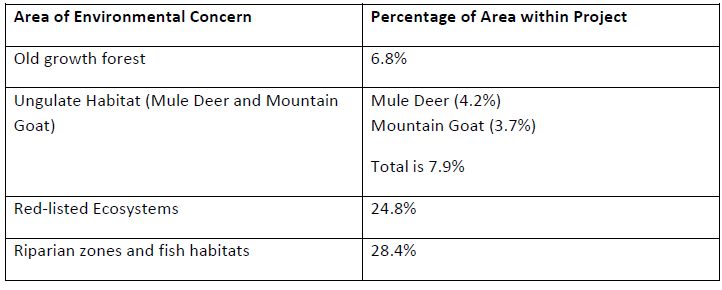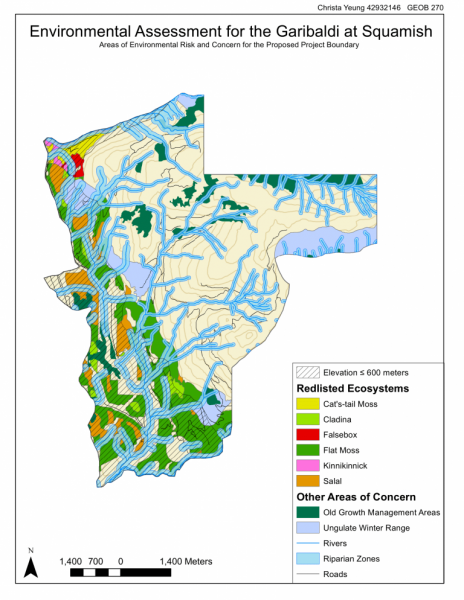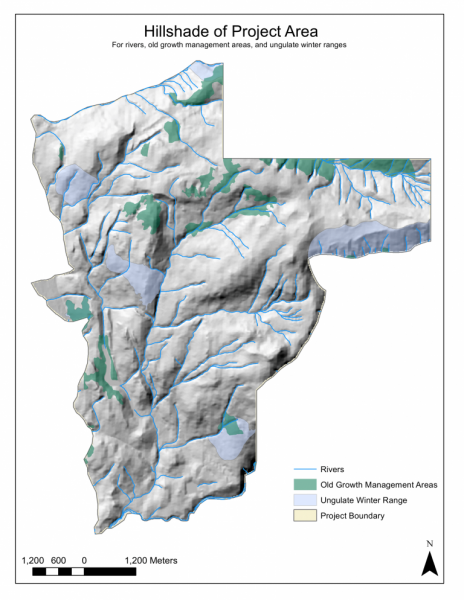In this week's GIS assignment I have been tasked with performing an environmental impact assessment of the proposed Garibaldi resort in Squamish.
The Garibaldi at Squamish Project
The Garibaldi at Squamish project is a proposed all-year mountain resort on Brohm Ridge, which will include 124 ski trails, 21 lifts, along with commercial developments to attract tourism. While the project has been in discussion since 1997 and boasts an increase of over 3000 jobs over years it will be built, there have been barriers in approval of the project. Namely, the BC Environmental Assessment Office and Resort Municipality of Whistler have criticized the project’s potential effects on vegetation, wildlife, economic viability, and climate
change. As a natural resource planner speaking on behalf of Northland Properties and Aquilini Investment Group of Vancouver, I have evaluated the above criticisms and made recommendations of priorities that will need to be addressed as the Garibaldi project moves forward. I have also produced a map of possible environmental concerns in project attached to this document (See above image).
Hillshade Map of Garibaldi Project
Findings of Areas of Environmental Concern
To perform this assessment I have compiled data of the biodiversity that may be affected within the project area; this data is sourced from DataBC. These areas include ungulate winter habitat ranges, old growth forests, red-listed terrestrial ecosystems, and riparian zones which surround the rivers. I have also identified areas below the elevation of 600m which may potentially not have enough snow for ski trails. This amounts to about 31.7% of the project area (4298 acres) which is unfit for skiing. By layering these different spatial factors I was able to identify and visualize the area that is of environmental concern for the resort development.
In general, I have found that about 53.6% of the Garibaldi project includes areas of environmental concern and protection above. This amounts to about 7300 acres of the 14000 acre project. I have summarized my findings in the table below:

Recommendations Moving Forward
The percentage of areas of environmental concern are top priorities in the development of the ski ranges and I recommend Northland Properties and Aquilini Investment Group of Vancouver to be cautious of where they locate the ski-resort’s trails and facilities so that they are the least disruptive to these sensitive biodiversity zones.
I suggest that the two greatest environmental concerns to project development include riparian zones and fish habitats, and ungulate habitat, which cover a significant amount of areas of over 600m elevation where skiing facilities would be developed. To mitigate effects on these already sensitive environments, I recommend the developers to consider methods of construction and operation that create the least amount of disruption and pollution (runoff, noise pollution, greenhouse gas emissions) in the short-run, and regular monitoring of rivers and ungulate habitats so that further damage is not done.
Conclusion of Environmental Assessment
This environmental assessment has found that over half of the Garibaldi project contains areas of environmental risk, old growth forest, threated ungulate habitat, red-listed ecosystems, and riparian zones, all of which must be a high priority in the development of the project as it moves forward. Since the resulting area that is safe for development only amounts to about 46% and there are significant environmental regulation barriers to the project, I recommend both proponents to review the extent and range of property development on the resort in consideration of whether these limits will still attract the investment originally intended. Other priorities I recommend would be further research in the viability of a resort where seasonality and climate change risk its profitability and continued consultation with the Squamish Nation so that the Garibaldi project is also socially sustainable.
Reflection on Week 4 –Environmental Assessment of Garibaldi Project
This was the most interesting and most challenging of the 4 weeks of GIS assignments because it engaged with a contentious development with many ethical implications. Personally, I do not believe the project should continue for the reasons of threatened environments listed above, however, early in this year, the project had been received environmental approval. My hope is that Northland Properties, Aquilini Investment Group of Vancouver, and other proponents have made appropriate changes to protect the ecology at risk while ensuring the social sustainability of the project as well.
Here are some skills I picked up in summary:
- Acquired BC Government TRIM data using the online DataBC database to perform an environmental impact assessment of a ski range
- Reclassified a DEM based on elevation to identify appropriate land for a ski range
- Built a multi-field query using the Select by Attribute tool to identify red listed ecosystems, ungulate winter ranges, and old growth forest
- Produced an environmental assessment map of the Garibaldi at Squamish project to highlight ecologically sensitive factors to development
- Produced 3D hillshade map of environmental assessment to highlight topography and slope of project area
- Wrote a memo directed to project proponents outlining the project objectives, findings, and recommendations


